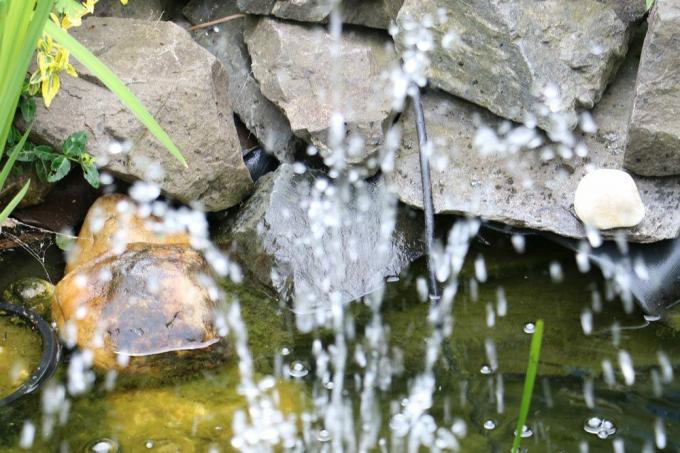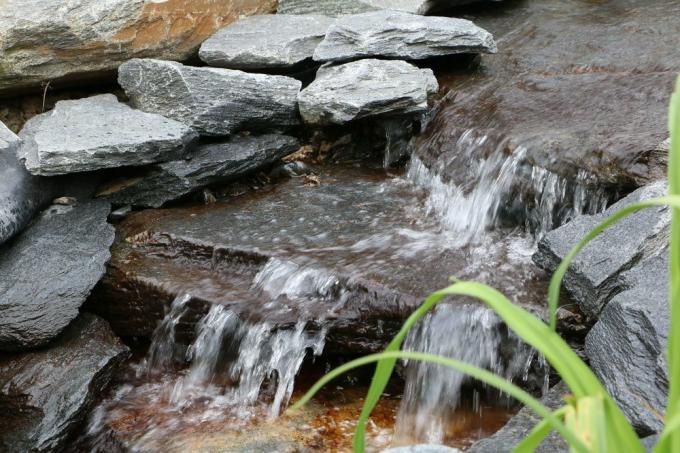
table of contents
- Carbonate hardness
- Lower the KH value
- Add water
- Water change
- UV-C lamps
- Increase the KH value
- calcium carbonate
- Conditioning agents
The quality of the water is crucial for the balance in the pond. In addition to the total hardness, the carbonate hardness (KH) is an important aspect that must be taken into account. The KH value has a decisive effect on the pH value in the pond water. If the value is too high or too low, many processes in the garden pond run incorrectly or not at all. For this reason, it is important to know how to lower or increase KH levels.
Carbonate hardness
Before using any measures to decrease or increase the carbonate hardness, you need to know about the recommended values. The carbonate hardness is the value of the dissolved minerals in the water. These include:
- calcium
- magnesium
- beryllium
- strontium
- barium
This makes it possible to specify the acid binding capacity that currently prevails in the pond and has a corresponding effect on the biological processes in the small ecosystem. It can happen that the carbon hardness value of the
Pond water is too high or too low for various reasons. This has a strong effect on the buffer effect, which supports the natural cleaning of the pond. The following list gives you an overview of the individual KH values:- too low: below 5 ° dKH
- good: 5 ° dKH to 14 ° dKH
- optimal: 6 ° dKH to 10 ° dKH
- too high: over 14 ° dKH
Please note that the pond water must have a different hardness than aquarium water. This is because aquariums are not exposed to the following influences, which noticeably affect the value:
- weather
- wild pond inhabitants
- wild plants
- organic waste (example: leaves)
- Sun
- Seasons
The weather in particular causes the value to change almost daily. For this reason, the value remains much more stable in an aquarium, while you have to pay more attention to it in the pond.

Note: To measure the KH value of your pond water, there are various tests that you can purchase in stores. The droplet test should enable the most accurate measurement, but test strips that you can use on your own are just as effective.
Lower the KH value
A KH value that is too high is much rarer than one that is too low. However, it cannot be ruled out that your pond may have problems due to an excessively high carbonate hardness. If the carbonate hardness is too high, the total hardness increases together with the concentration of CO₂ within the water, which in the long term has a negative effect on pond equipment such as pumps or filters. In addition, if the CO₂ level is too high, the pond's self-cleaning function no longer works because it is deposited in the water and cannot escape. Causes for a too high KH value in the pond water are:
- Pond care products
- mineral-containing stones
- Lime water
Hard water is often observed with a carbonate hardness that is too high. For example, if you have added hard water at regular intervals, this increases the KH significantly. There are three methods available to lower the KH again.
tip: Avoid adding peat to the pond, as this does not really soften the water, but only has a softening effect for a short time. As such, peat only releases acids into the water, which lowers the pH value, but not really the KH.
Add water
The addition of fresh water, which causes softening, is particularly easy and immediately noticeable. With this variant, you should use the following types of water in order to reduce the high lime content that is present in most cases:
- Rainwater
- Well water
- filtered water
Always add a little more fresh water to the pond circuit over a period of several days so that the carbonate hardness can adjust. Check the KH of the pond water from time to time to follow the course. Since lowering the KH value can happen very quickly, you have to stop early, otherwise the carbonate content will drop sharply. For this reason, check the pond water for the KH at regular intervals.
Water change
If the water in the pond is clearly too hard, you can also change the water. Since the water binds the carbonate, you can reduce the value quickly and effectively by replacing it. In most cases, this does not even require a complete water change, as fresh water also has a positive effect on the KH value, as described above. Also use one of the above-mentioned water types for the water change in order to be able to benefit from the low-calcium water for a long time.

UV-C lamps
Another method is the use of UV-C lamps. These are UV lamps which, with their wavelengths of 315 to 280 nm, are able to soften the water, which at the same time affects the carbonate hardness. Depending on the size of the pond, you will need a different number of lamps that you can shine directly onto the water surface. The following points should be observed when using the lamps:
- low wattage
- effective pond filter system
- use permanently
Again, it is important to regularly measure the water values to find out the current hardness. You can use this to find out when you will no longer need the lamps. Since you have to leave the lamps on permanently for this method, it gnaws your wallet a lot. For this reason, you should select lamps with a low wattage indicated in the list, as they consume less energy.
Increase the KH value
If the carbonate hardness is too low, you have to increase it in order to prevent strong fluctuations in the pH value. If the KH is too low, there is an imbalance between carbon dioxide and lime in the pond water, which increases the toxicity. Above all, the concentration of nitrite and ammonium should be mentioned here. The water stagnates, which hinders the self-cleaning of the pond and can seriously affect the pond inhabitants. Possible causes for this problem can be:
- constant rains
- lack of fresh water
- Missed water change
Simply adding fresh water to the pond or changing the water can solve the problem on its own. However, this is not always the case and you have to rely on other methods, especially if a water change is not possible at the moment, for example. There are two methods for doing this.
Note: Avoid adding rainwater, as this would lower the KH value even further. Because of this, many people struggle with this problem in areas with high rainfall.
calcium carbonate
Calcium carbonate (CaCO₃) has established itself as an ideal means of increasing the KH value and can be used without any problems. This agent is carbonate of lime, which is added to the water in certain quantities and thus has a corresponding effect on the KH. You have to use the calcium carbonate over a long period of time because it only works slowly, but it is also the gentlest option for your garden pond. CaCO₃ is available on the market in the following forms:
- CaCO₃ powder
- Shell grit
- Chalk lime
These have a high content of CaCO₃ and are available for a price of one to 15 euros per kilogram, which depends on the product in question. Make sure that you grind the sediment as finely as possible, as this is the only way it can work in the water. It is applied in the following way:
- Fill CaCO₃ into the multi-chamber filter
- alternatively fill in the stream
- check water values daily
- refill if necessary
The hardening of the KH value in this way can take a little longer, as the pond can only increase by a maximum of 1 ° dKH per day. If you use too much calcium carbonate, the carbonate hardness in the pond water increases too quickly and can also have a negative effect on it. For this reason, check the water values daily until you have reached a good KH value. Patience pays off with this method.

tip: If you are the proud owner of a stream, you can place limestones in it to harden the water. The water dissolves the calcium carbonate from the limestones over time and in this way regulates the KH in the pond excellently and with little effort.
Conditioning agents
As an alternative to adding a form of calcium carbonate, you can use ready-made processing agents from specialist retailers or hardware stores. These are agents that you add to the water according to the manufacturer's instructions in order to increase the KH within a short period of time. Most of these products increase the value to a range from 6 ° dKH to 8 ° dKH, which is ideal for the water. Select the appropriate product according to the amount of pond water. Each of the means is sufficient for a certain amount of water in the pond, with the majority of the products being designed for a water amount of 2,000 to 3,000 liters.


